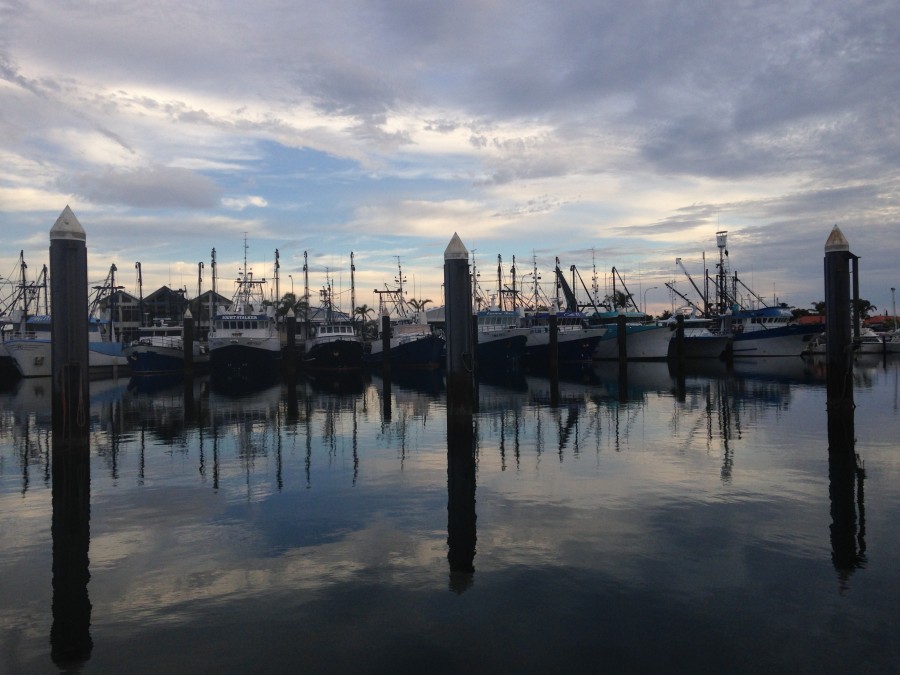After almost two solid days of transit from American Samoa to Australia, I touched down in Sydney Wednesday evening. I was tired and worn down, but happy to see Jayne Jenkin’s smiling face in the airport. I would be spending the next two nights with her and Colin in their beautiful home in Manly before heading down to Port Lincoln to volunteer with the Rodney Fox Shark Expeditions (RFSE).
I had only one full day in Sydney and used almost half of it running errands with Jayne, which was much needed for both of us. It was also a nice way to get out and see some of the area, as I’d never really spent any time in Australia (besides a short, 2 day layover back in October). We spent the rest of the afternoon back at Jayne’s home, allowing me some time to repack and organize my bags for my trip to Port Lincoln the next day. To end the day, the three of us walked down to have dinner with diving legend Valerie Taylor, who is good friends with Jayne. It was an incredible honor to meet someone so renowned in the diving industry!
By the time Friday morning rolled around, I was all packed up and ready for my next adventure diving with the great white sharks! This was a dream I have had for several years but never thought I’d get around to for a long time – to be heading off for almost 3 weeks of cage diving felt incredibly surreal. Colin dropped me off at the airport and I was on to my next adventure! It would be two short flights to Port Lincoln (with a brief stop over in Adelaide) where I was picked up from outside the airport by the local shuttle and dropped off at the marina, where the Princess II is docked. I had almost no idea what to expect my three weeks to be like, but boy, was I excited for them! I was met onboard by Mike, the trip leader when Andrew isn’t onboard. He gave me all the paperwork to fill out and then gave me a brief tour of the boat. We’d have guests arriving the next morning at 11 AM, so the boat was quite clean and organized, with only a little more tidying needed in the morning. Jade, the chef, arrived later that night from the airport and we spent the evening getting to know one another before heading to bed early.
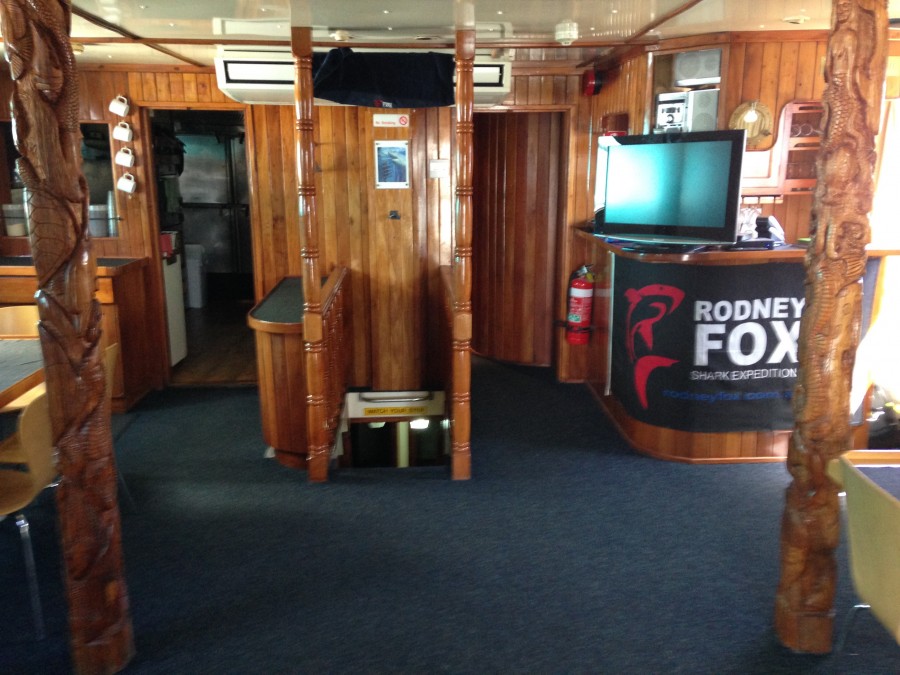
We spent the early morning of Saturday doing the final preparations for the guests – including stocking all the food and drinks, vacuuming, and any other random tidying up that was needed. My first trip would be special as Andrew, the owner, would be tagging along. When I made my plans to volunteer several months earlier, Andrew was unable to join any of the trips I would be on for (which was really unfortunate for me!) but due to some last minute changes, he could join my first trip out! It definitely made me nervous to have him onboard for my very first trip, but I was really looking forward to spending at least one trip with him. The guests were picked up right around 11 AM. As they were briefed and filled out paperwork, we took off from Port Lincoln, starting the journey up to the North Neptune Islands. It would take us about 4 hours to steam up to our anchor point and we couldn’t have asked for better weather – the seas were flat and calm with little wind and lots of sunshine! It was definitely a good start to an amazing 3 weeks. We ate lunch while motoring out to the North Neptunes and set anchor in the early afternoon. Once the anchor was set, everyone jumped into action getting the cages ready at the back of the boat. Berley was put out at the back of the boat and so were baited floats – RFSE is one of two operators in Australia allowed to use bait/berley to attract sharks for the cage dives. Within 20 minutes, we had a beautiful white shark circling around the back of the boat. It was my first ever glance at a white shark and I was stoked! None of the pictures I’d seen of the sharks compared to seeing them in person and even from the surface a “small” shark was massive!
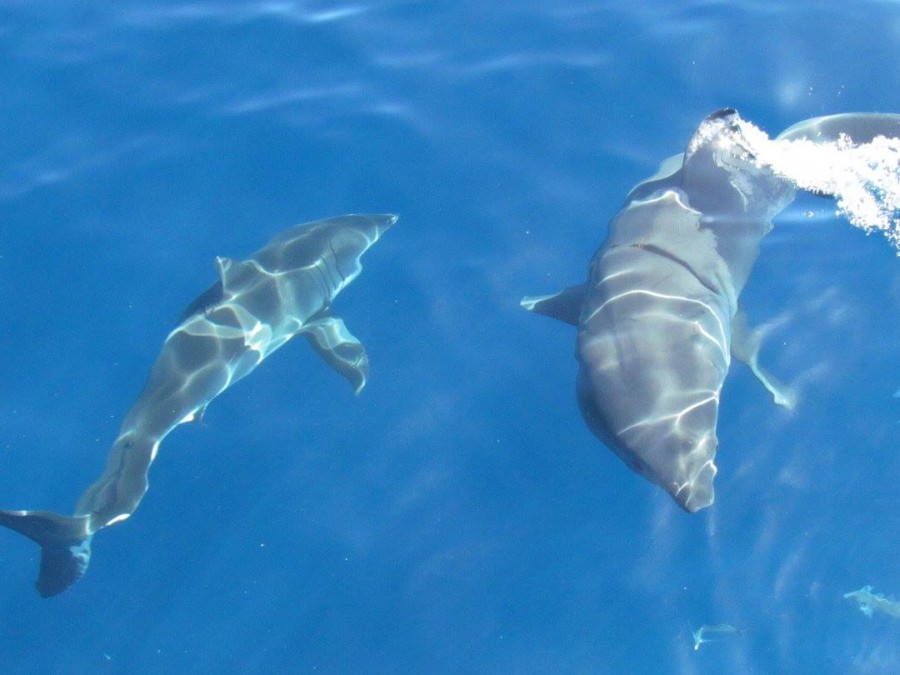
The guests were given a thorough dive briefing about the surface cage before they were allowed to hop in. We spent the rest of the afternoon helping guests in and out of the cages, working the baited floats (RFSE throws out pieces of tuna gills tied to floats and line to draw sharks in but they try to not let the sharks eat the bait to keep them from being “trained” – the bait’s purpose is to draw sharks in close to the cage but not to feed the sharks), and spotting sharks from the viewing platform (which is helpful for the people working the baits to know which direction sharks are approaching from).
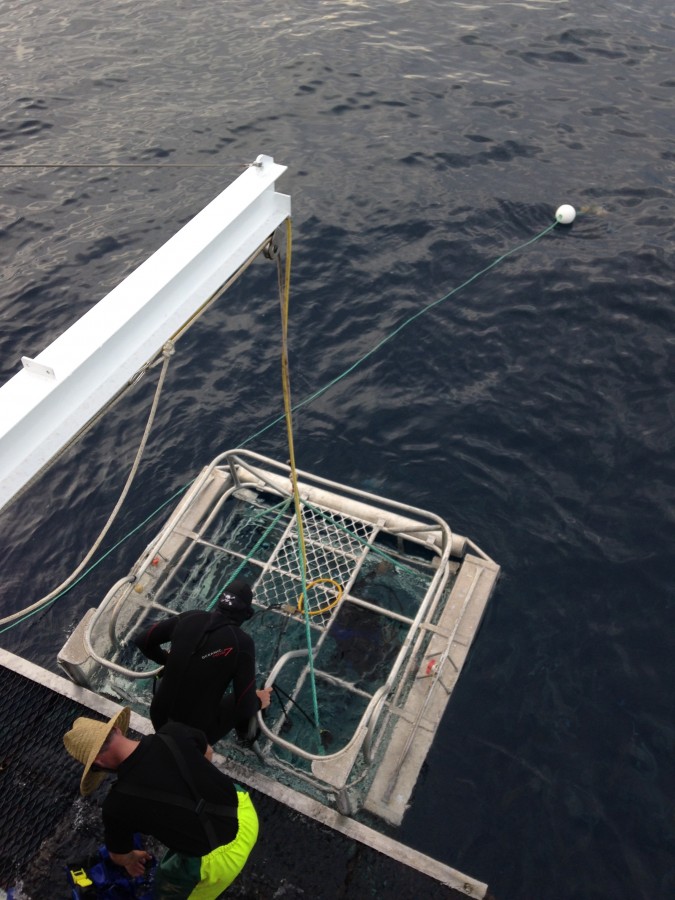
It was a hectic afternoon for me – I was learning almost everything as I went and in addition to helping out on the back deck, I was running around in the kitchen helping wash/dry dishes, restock sodas, take out the recycling/trash, and all sorts of odd jobs needed. We eventually decided to pull in the surface cage for the evening as the sun was low in the sky (due to the long summer days, the sunset isn’t until 8:30 or so which maximizes dive time) and let everyone get ready for dinner. The cage was pulled out of the water and secured at the back of the boat, the baits and berley were all pulled in, and the back deck was tidied up. My first full day volunteering was done and although there were times I felt completely useless, I was learning fast thanks to the incredible team and I was excited for what the next day would bring! We had already had an amazing day with at least 10 male sharks who were all very active, with some crazy breaches – and this was all I’d seen from just the back deck!
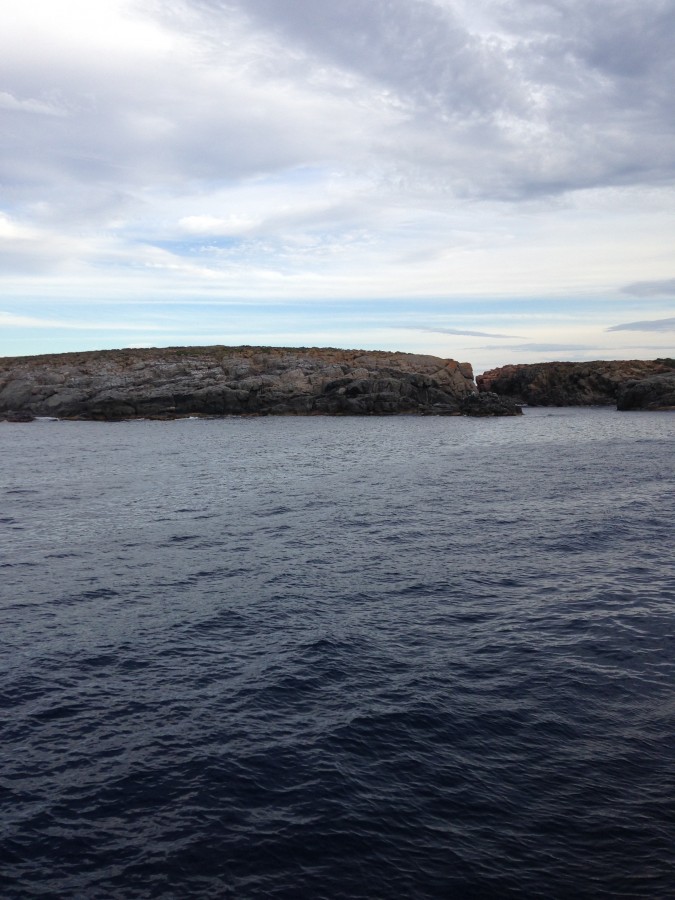
Sunday started early – by 6:30 we had the berley going and bait in the water and just before 7 we had sharks around the back of the boat and the surface cage already in the water, ready to go. The guests were all pretty eager and after breakfast, most of them were ready to get in the surface cage and get the day started!
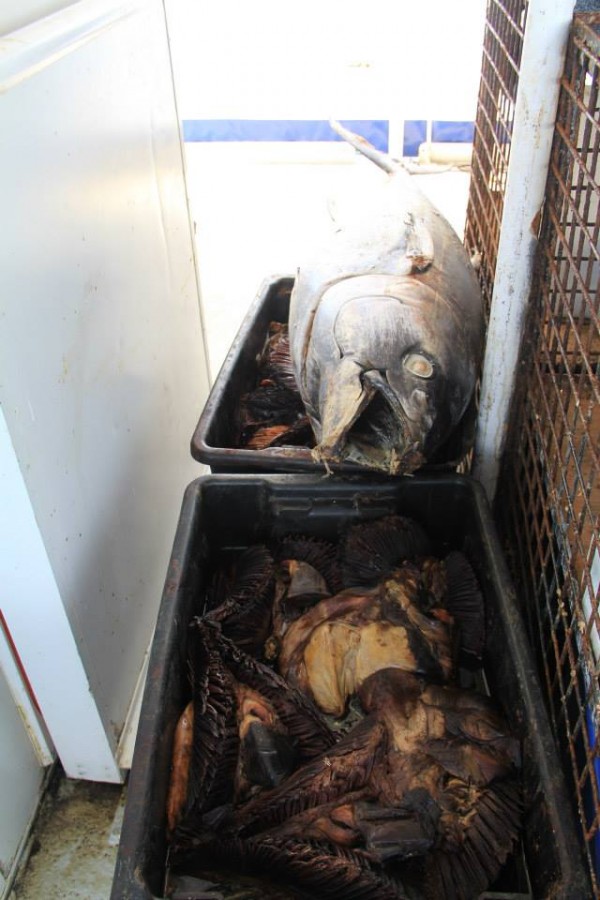
We spent a few hours doing the surface cage (enough so everyone had a chance in the surface) and then gathered everyone for the bottom cage briefing. What makes RFSE so unique is that they are the only operator in the world that offers ocean floor cage diving – and with that a totally different way to observe the white sharks. As a new volunteer, it was uncertain if I’d be able to hop in a bottom cage rotation. The cage can hold 3 guests and a divemaster, so the amount of guests (and Andrew’s discretion) would dictate if I’d be able to dive this trip. I had good fortune in my favor– out of the 12 guests, 11 were bottom cage diving, which meant the last rotation had one free space and Andrew kindly let me tag along. I was excited out of my mind to be diving with the white sharks (but tried hard not to act giddy, as I still had loads of work to do around the boat). I was put on the last rotation (with Andrew no less!) so spent the late morning learning how to help guests gear up and get in the cage, launch the bottom cage, work the safety rope, then get the cage back up and secured to let guests off. I spent the first three rotations running around like a wild woman, learning all these new roles and trying to make sure Jade always had plenty of help in the kitchen. I was being worked hard on the Princess II and I absolutely loved it. Finally, it was my turn to go diving and it didn’t feel real. I suited up in a 7mm, donned the tank, and clumsily climbed into the cage.
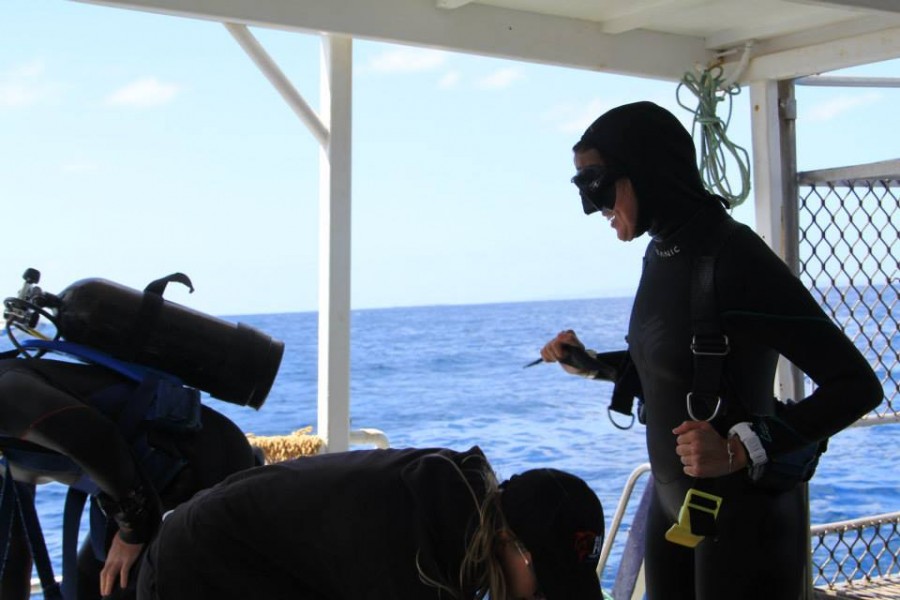
In addition to Andrew, who was operating the cage and taking photos, Jon Shaw (renowned videographer) was in my cage and would be trying to get good footage of the whites in their natural environment. I really didn’t know what to expect but gasped with excitement as the cold water surged up my wetsuit as we plunged down into the blue waters. We slowly descended down past the school of trevally and kingfish that had aggregated at the back of the boat, with the shape of the seafloor slowly emerging as we were lowered down. Andrew stopped the cage just a meter or so off the sandy bottom and within moments we had a white shark within view – it was so much more amazing then I’d imagined. I’m pretty sure my eyes were the size of dinner plates for the whole dive, as we had 3.5 – 4 meter white sharks slowly circling around the cage for the entire dive. In addition, Andrew with his camera and Jon with his camera were both leaning out of the cage, attempting to get up-close images of the beautiful sharks as they passed by. After about 35 minutes at the bottom, Andrew signaled for the crew topside to slowly start lifting the cage back up to 5 meters for our safety stop. I was dumbfounded. I had just done my first cage dive with white sharks, plural. Not one that came briefly and left. Multiple sharks that swam right up and around our cage for the whole entire dive! The white sharks made every other shark I’d seen to date look small. Despite my complete and utter amazement from the dive, upon reaching the surface and clambering out of the cage, it was straight back to work. I hustled out of my dive gear and started helping the next group of divers get ready for their second round of diving. I managed to squeeze in a quick lunch between working the safety rope, restocking sodas, drying dishes, and helping kit up divers.
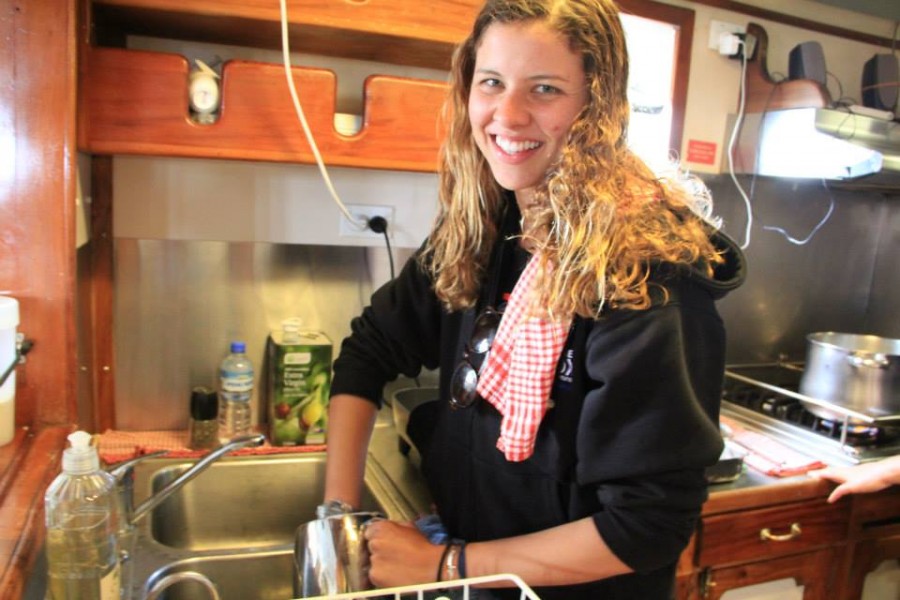
By mid-afternoon it was our second chance to get back in the bottom cage and this time I think I was even more excited about the dive! It was another incredible dive with up-close encounters with multiple white sharks. Once we finished the dive, we secured away the bottom cage and set baits back out in the water to finish the day with a long surface cage session. Once everyone had their fill of cage diving for the day, we put up the surface cage and then I had another unique opportunity. In addition to being the only company that does ocean floor cage diving, RFSE is the only operator allowed to go on land at the Neptune Islands, which offers an intimate look at the New Zealand Fur Seal colonies that call the islands a safe refuge from their shark predators. With the zodiac in the water, guests were invited to do a tour on one of the North Neptune islands, and I joined in. We spent the late evening walking around the rocky island, led by Dani (one of the divemasters who had been really good at teaching me the jobs I needed to do), watching the fur seals lounge in the shallow pools or sleeping on rocks further ashore. It was a perfect end to the day and after an hour or so, we loaded back into the zodiac and zipped back to the Princess II for dinner.
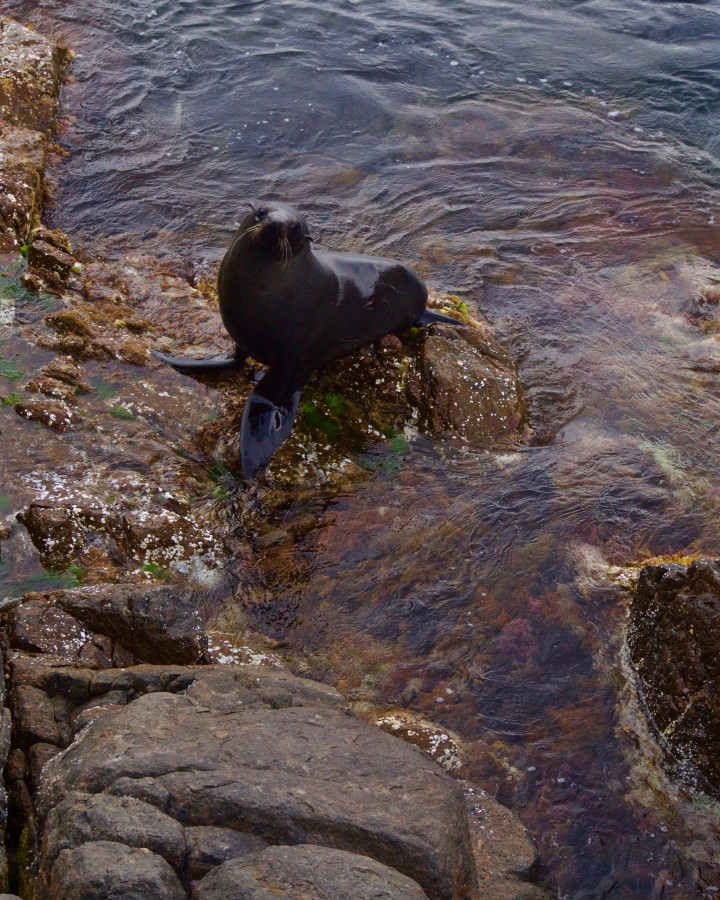
Monday, although the last day of the trip, was still jam-packed with diving! We had another early start, with bait in the water well before breakfast and sharks around before many of the guests had even woken up. We did another surface cage session just after breakfast before getting the bottom cage ready to get in the water. There was one quick change in plans, as Andrew had to get a fast boat back to the mainland to head back to Adelaide where Jen, his partner, was in labor. It was sad to see him leaving the trip early but we all wished him luck as he rushed off to be with Jen. Mike and Andrew planned to do another two rounds of bottom cage diving that day and we got the first group ready to go in the bottom cage by 9:30 or so. I still was given the chance to go down in the bottom cage and after everyone did their two rounds, we packed up the bottom cage. We let the guests do another surface cage session – with loads of action from the sharks, which were definitely putting on a good show for us, breaching multiple times and coming nice and close to the cage – before we needed to pack up for the evening. We needed to get back to Port Lincoln that evening and by 6 PM began the slow steam back to the marina. We had dinner en route to a fantastic sunset and by 10 PM or so had reached our slip and docked. I had my first trip done with and even though I had a lot of learning left, I felt like I was already getting into the swing of things. I was grateful for the crew and how great they were at teaching me all the new things I needed to learn, while having a bit of grace with me when I made mistakes.
